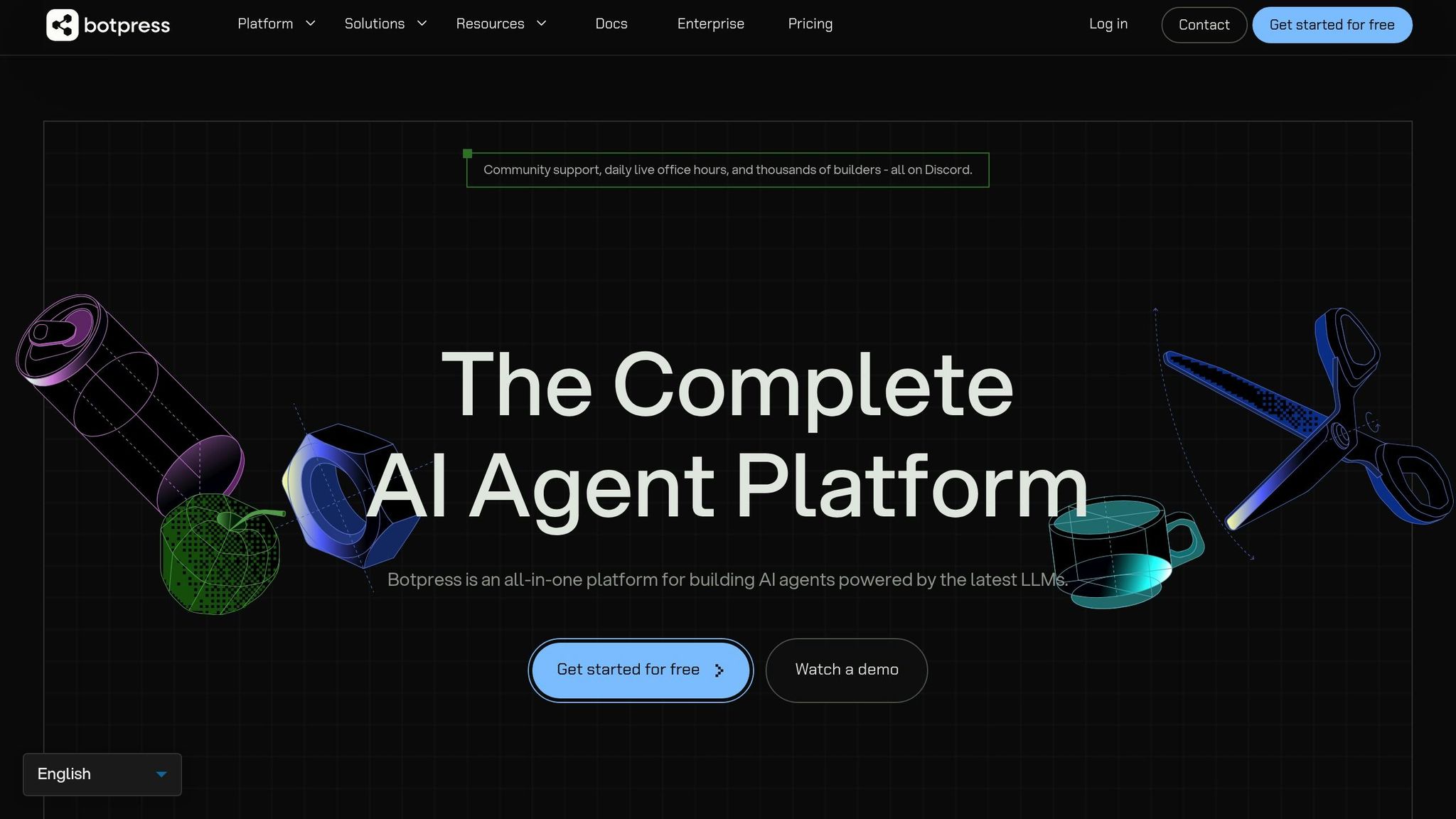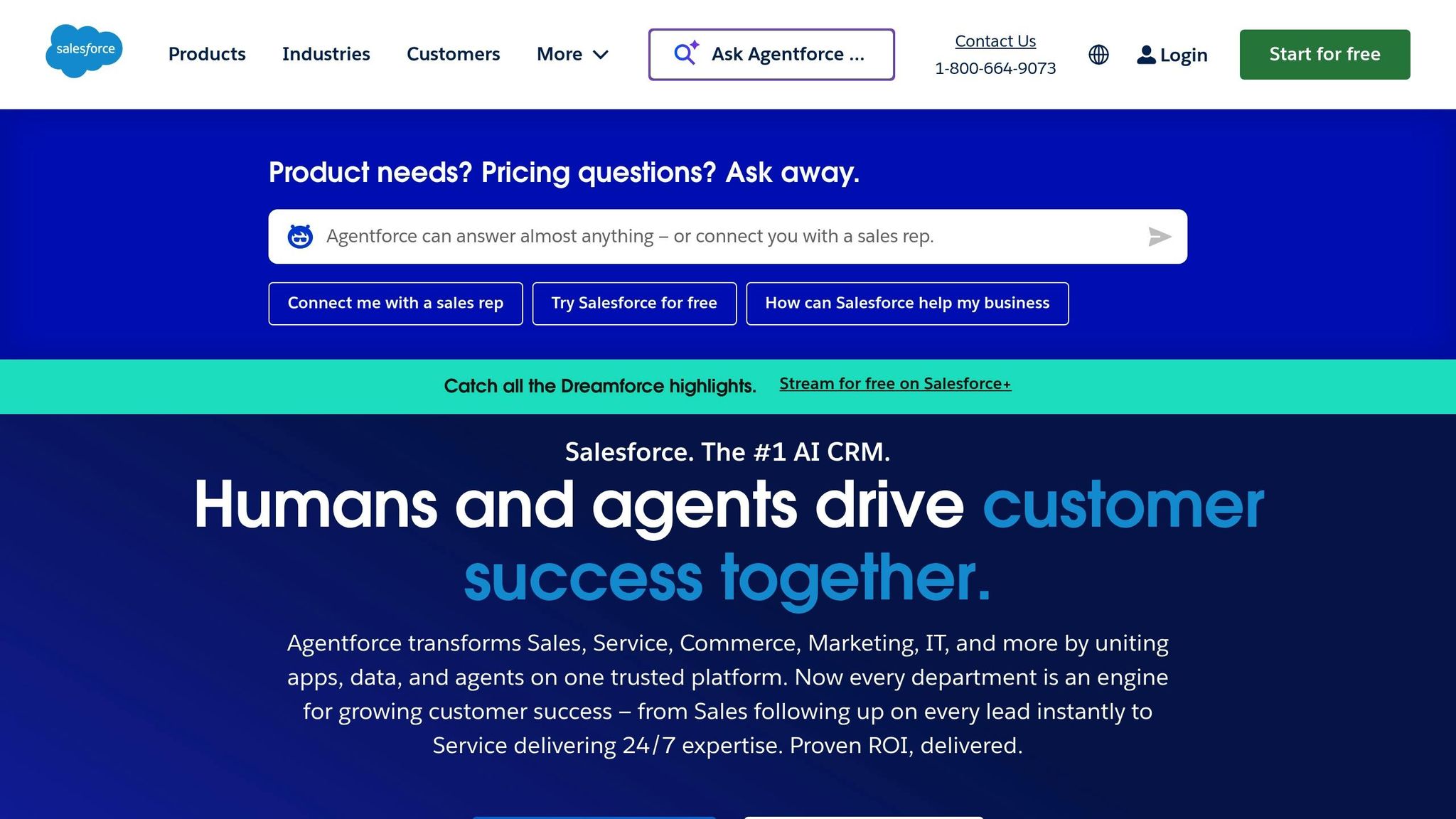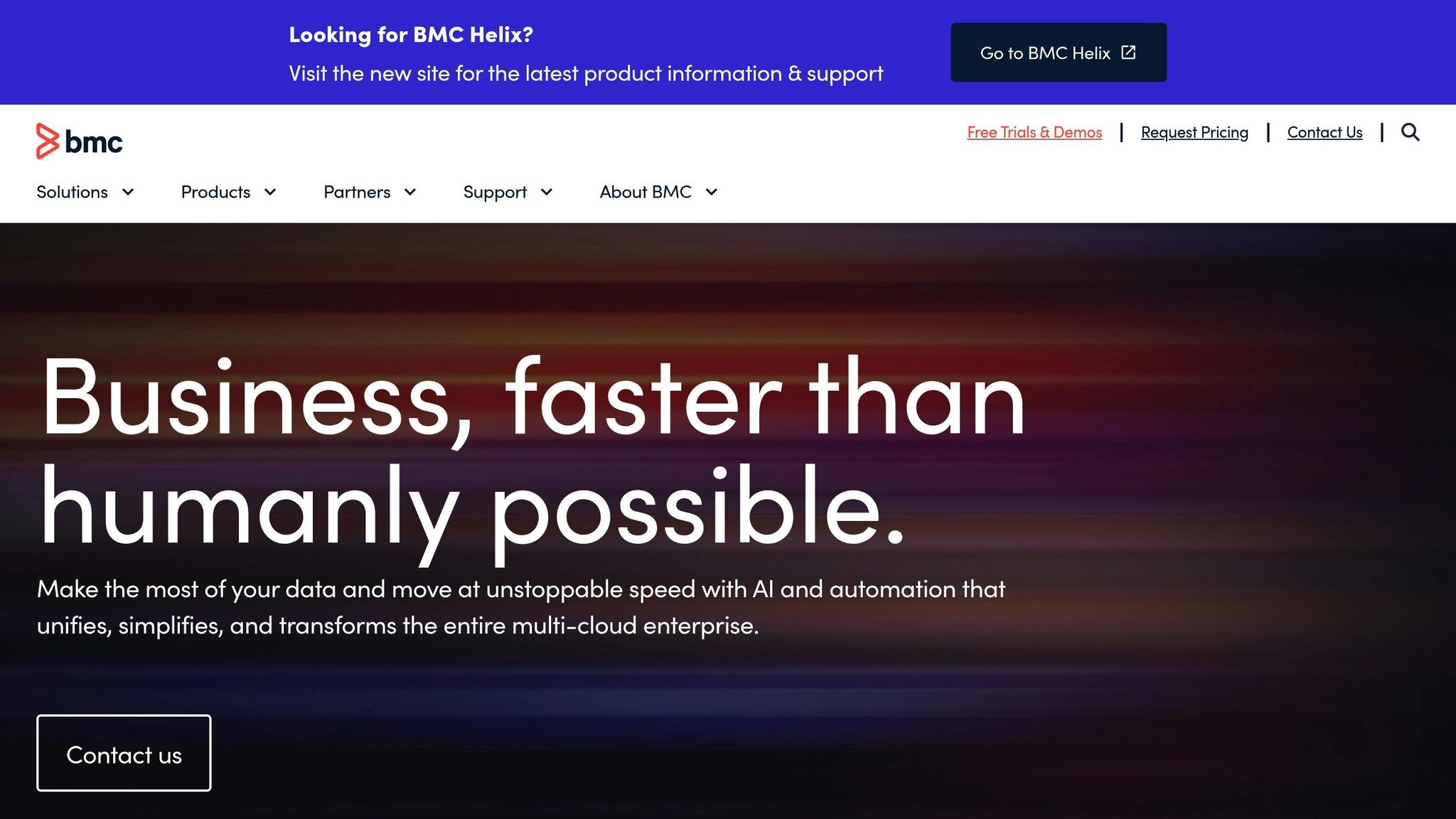
Today, AI is at the heart of how businesses operate, enabling smarter decisions, automating tasks, and improving efficiency. With 75% of organizations experimenting with AI and 80% of employees reporting productivity boosts, it’s clear AI is no longer optional - it’s essential for staying competitive.
Here are 10 powerful AI tools reshaping industries:
Quick Tip: Start with tools like Prompts.ai to unify your AI workflows, reduce costs by up to 98%, and ensure compliance with robust security features.

Prompts.ai is an enterprise-grade AI orchestration platform designed to simplify the management of multiple AI tools while addressing concerns around cost and security. By uniting over 35 leading large language models - including GPT-5, Claude, LLaMA, and Gemini - into a single, secure interface, the platform enables businesses to centralize and streamline their AI operations.
A standout feature of Prompts.ai is its emphasis on scaling prompt engineering. Many organizations face challenges in creating, testing, and deploying effective prompts across teams. Prompts.ai solves this by offering tools to systematically build, manage, and refine prompts. Teams can collaborate using version control and approval workflows, ensuring consistent quality and alignment across departments. This unified system seamlessly integrates with existing business workflows, making it an indispensable tool for enterprises.
Prompts.ai effortlessly integrates with popular productivity tools, CRM platforms like Salesforce, and project management systems. This allows businesses to generate prompts and automate tasks directly within the tools they already use.
A mid-sized marketing agency demonstrated the platform's potential by connecting it to their CRM and project management tools. This integration automated client communication and campaign reporting, cutting manual workloads by 30% and boosting client satisfaction scores by 20%. Additionally, Prompts.ai supports connections to major LLM providers, enabling businesses to work with multiple AI models through a single, unified system.
Built with enterprise needs in mind, Prompts.ai offers centralized management for prompts, user roles, and permissions, making it easy for large organizations to deploy AI solutions across departments while maintaining control.
Key features include shared libraries for prompts, team-specific access controls, and analytics dashboards that offer insights into usage patterns. These tools ensure that as teams expand, the platform scales seamlessly, maintaining performance and usability.
For businesses operating under strict regulations, Prompts.ai offers robust governance tools to address data security and compliance requirements. Features like audit logs, data encryption, and customizable access controls ensure sensitive data is protected.
These tools are particularly valuable for industries with stringent regulatory standards. The platform can generate compliance reports and track prompt usage to meet frameworks such as GDPR and CCPA.
Prompts.ai tackles the challenge of managing AI expenses with its integrated FinOps features. Businesses gain real-time insights into AI spending, tracking token usage across various models and teams. This transparency helps optimize costs and eliminate unnecessary expenses.
Organizations adopting Prompts.ai often see a return on investment within the first year, thanks to reduced labor costs and improved efficiency. Some companies have reported saving thousands of dollars annually. The platform’s pay-as-you-go TOKN system aligns costs with actual usage, offering savings of up to 98% compared to maintaining multiple standalone AI subscriptions.

Make is a platform designed to simplify workflow automation by connecting various applications and automating repetitive tasks. With its intuitive drag-and-drop interface, teams can create workflows without the need for coding expertise. Similar to Prompts.ai, Make enhances operational efficiency with its powerful integration features.
Make provides ready-to-use connections to a broad array of business applications, including widely-used tools like Google Workspace, Microsoft 365, Salesforce, HubSpot, Slack, and Shopify. Its real-time data synchronization ensures seamless updates across systems, breaking down data silos. Moreover, Make supports webhooks and custom HTTP modules, allowing it to integrate with virtually any web service - even older, legacy systems.

Botpress is an open-source conversational AI platform designed to help businesses create and manage chatbots with ease. Its standout feature is a visual flow builder, which simplifies the process of designing conversational workflows. This tool not only improves customer interactions but also streamlines internal communication. The platform is built to handle growth, making it a strong choice for businesses of all sizes.
Botpress is well-suited for enterprise-scale deployments, offering the flexibility to handle increasing workloads as your team and needs expand.

Aisera builds on the momentum of conversational AI, offering an enterprise-grade platform designed to automate service management across customer support, IT operations, and internal workflows. By leveraging natural language processing, Aisera doesn’t just streamline tasks - it transforms how businesses manage and deliver services.
One standout example comes from a leading U.S. healthcare provider that implemented Aisera. The result? A 60% reduction in ticket resolution time and a noticeable boost in employee satisfaction, thanks to the instant handling of routine requests.
Aisera’s API-driven framework integrates effortlessly with enterprise tools like ServiceNow, Salesforce, Microsoft Teams, and Slack. This enables automation across ticketing, customer support, and operational workflows. With features like end-to-end encryption, secure API gateways, and constant monitoring, Aisera ensures sensitive data remains protected at all times.
Designed with enterprises in mind, Aisera can process millions of support requests every year with minimal delays, making it ideal for large-scale operations.
Meeting regulatory demands is a priority for Aisera. The platform includes governance tools like role-based access controls and advanced data encryption. It also supports compliance with key U.S. standards, such as HIPAA, SOC 2, and GDPR. Features like HIPAA-compliant audit trails and automated policy enforcement ensure businesses stay aligned with these regulations.
Aisera helps organizations cut costs by automating repetitive tasks and reducing reliance on manual labor. For instance, a U.S.-based company reported a 40% drop in support expenses within the first year of implementation, achieving a full return on investment in under 12 months. Businesses can monitor metrics like average ticket resolution time, first-contact resolution rates, and overall cost savings to measure productivity gains and validate their investment in AI automation.

Jitterbit simplifies workflows by connecting cloud-based and on-premises applications, data sources, and processes. This integration helps businesses build a smoother and more efficient digital environment. By bringing together diverse systems effortlessly, Jitterbit enables organizations to operate with greater flexibility and cohesion.

ServiceNow reshapes how businesses handle operations by offering a unified platform that connects departments, automates workflows, and delivers actionable insights. With AI-driven capabilities, it simplifies complex processes across areas like IT service management and human resources.
ServiceNow stands out for its ability to connect different systems, creating a cohesive technology ecosystem. Its Integration Hub offers pre-built connectors for hundreds of widely used business applications, including Microsoft Office 365 and Salesforce. This ensures that teams can interact with multiple systems from a single interface.
The Flow Designer empowers users without extensive coding expertise to build automated workflows. For example, you can configure triggers to route requests, update records across platforms, and notify stakeholders when specific conditions are met. Picture this: an employee submits a new hire request, and ServiceNow automatically sets up accounts in your HR system, orders equipment via your asset management tool, and schedules onboarding sessions in your calendar.
For custom or legacy applications, ServiceNow's REST APIs eliminate information silos, enabling seamless connectivity and scalability across even the most complex organizational structures.
ServiceNow is designed to handle high volumes of requests while maintaining peak performance. Its multi-instance architecture allows businesses to segment operations by unit or region while maintaining centralized oversight.
Role-based access controls ensure that users see only what’s relevant to their roles. For instance, help desk agents can access incident tickets and knowledge articles, while managers view performance dashboards and approval queues. This tailored approach boosts efficiency and reduces distractions.
The platform also excels in workload management, distributing tasks evenly based on team members' skills, availability, and workload. This prevents bottlenecks, ensuring that no one is overloaded while others are underutilized.
ServiceNow emphasizes governance and compliance through features that ensure transparency and security. Its audit trails meticulously log every action, capturing details like who made changes, when they occurred, and what was modified. These records are invaluable during regulatory audits or internal reviews.
Sensitive actions are safeguarded by approval workflows, which can be configured to require multi-level authorizations. If an approver doesn’t respond within a set timeframe, the system can escalate the request automatically.
Data encryption protects information during transmission and storage, while single sign-on integration minimizes password-related vulnerabilities. ServiceNow also supports compliance frameworks such as SOX, HIPAA, and GDPR, offering templates and automated controls to help organizations meet regulatory requirements.
ServiceNow reduces operational costs by automating repetitive tasks, allowing teams to focus on initiatives that drive growth. Its self-service portal empowers employees to address common issues on their own. They can search a knowledge base, submit standardized requests, and track progress - all without involving support staff.
The platform’s analytics and reporting tools provide valuable insights into performance metrics like resolution times and resource utilization. These data points highlight inefficiencies and guide decisions on staffing, process improvements, and technology investments.
ServiceNow’s predictive capabilities use machine learning to identify potential issues before they become problems. By analyzing historical data, the platform alerts teams to risks and suggests preventive measures, minimizing downtime and avoiding costly disruptions.

Salesforce uses AI to create smarter customer experiences and optimize workflows. Its well-regarded Agentforce platform provides automated tools that improve customer interactions while simplifying internal processes.
Agentforce connects smoothly with existing business systems, pulling in customer data like account histories and order details. This integration simplifies operations by automating tasks such as engaging leads, scheduling meetings, and guiding customers to the right resources. By automating these processes, businesses can manage workflows more effectively and foster proactive customer engagement.

SAP stands out as a key player in enterprise software, leveraging AI and machine learning to empower large-scale, data-driven decision-making. While specific details about its integration capabilities, scalability, governance, compliance, and cost efficiency are limited, SAP's longstanding reputation for advancing technology highlights its influence in shaping AI-powered business operations. The comparison table provides additional insights into its role in this transformation.

Workday collaborates with top enterprise AI platforms to simplify workflows and enhance operational efficiency. This partnership underscores Workday's pivotal role in the ongoing shift toward AI-powered business operations.
Workday's pre-built connectors ensure smooth integration with other systems, automating tasks while synchronizing activities across various departments. In July 2025, Moveworks showcased its integrations with Workday, Slack, Microsoft Teams, and ServiceNow, emphasizing their quick deployment and ability to deliver value swiftly for global enterprises.
Workday provides a flexible and scalable framework, making it an excellent choice for organizations experiencing growth. This scalability empowers businesses to achieve consistent efficiency improvements and make informed decisions.
Workday prioritizes security and compliance, offering enterprise-grade data protection, strong permission controls, and adherence to regulatory standards.
By streamlining HR and finance processes, Workday helps organizations reduce costs and achieve a faster return on investment.

BMC Helix is an AI-powered platform designed to simplify IT service management for businesses. By leveraging AI-driven automation and analytics, it helps organizations optimize their IT operations and speed up their digital transformation efforts. This platform complements our range of AI tools, offering a comprehensive solution for enterprise needs.
This table showcases how Prompts.ai provides streamlined AI management, cost savings, and robust security - essential elements for driving business growth.
| Tool | Best Use Cases | Starting Price (USD) | Key Security Features | Primary Benefits |
|---|---|---|---|---|
| Prompts.ai | Enterprise AI orchestration, multi-model workflows, cost optimization | $0/month (Pay-As-You-Go) | Enterprise-grade governance, audit trails, secure data handling | Access to 35+ LLMs, up to 98% cost savings, unified platform |
Prompts.ai stands out with its flexible pay-as-you-go pricing, starting at $0 per month, making it accessible for businesses of all sizes. By consolidating AI model management, it slashes software costs by as much as 98%.
Security is a cornerstone of Prompts.ai's platform. It offers enterprise-grade governance, detailed audit trails, and secure data protocols to ensure sensitive information is handled with care at every step.
Thanks to its cloud-native architecture, the platform scales effortlessly, enabling businesses to expand their models, teams, and use cases without disruption.
When selecting an AI solution, it’s crucial to align it with your technical requirements, budget, and long-term objectives. Prompts.ai delivers an efficient, secure, and scalable platform, empowering teams to achieve measurable results and drive innovation across their operations. This comparison highlights how Prompts.ai simplifies and strengthens AI transformation efforts.
For businesses in the US, embracing AI is no longer just an option - it's a necessity to remain competitive in today’s fast-moving landscape. The tools discussed here highlight how artificial intelligence can simplify operations, improve decision-making, and generate measurable results across various industries.
Achieving success with AI starts with aligning the technology to your specific business needs. Look for solutions that address your operational challenges while offering robust governance mechanisms, clear cost structures, and scalable frameworks that can adapt as your business grows.
When selecting AI tools, prioritize three key considerations: security and compliance, total cost of ownership, and integration capabilities. For example, Prompts.ai delivers strong governance and flexible pricing, enabling substantial cost savings while meeting the rigorous security standards that US businesses demand.
The most impactful AI transformations occur when organizations move away from piecemeal tool adoption and opt for centralized platforms. These platforms provide a clear view of usage, costs, and performance, reducing complexity and ensuring that AI investments translate into real business value instead of just technological experiments.
A centralized strategy, as demonstrated by the tools reviewed, forms the foundation of a successful AI implementation. Start by identifying your most critical operational challenges, then choose AI solutions that directly address those issues while offering the scalability and governance your business requires.
Prompts.ai places a high priority on data security and regulatory compliance, aligning with established frameworks like SOC 2 Type II, HIPAA, and GDPR. These protocols are designed to ensure that your sensitive information is managed with top-tier protection standards.
To provide ongoing oversight, Prompts.ai partners with Vanta for real-time monitoring of controls and has officially begun its SOC 2 Type II audit process as of June 19, 2025. These initiatives underscore a dedication to protecting your data and supporting businesses in meeting compliance requirements efficiently.
Using a centralized AI platform such as Prompts.ai offers businesses a powerful way to slash expenses by consolidating their AI tools. Rather than juggling the costs and management of 30–40 separate tools, companies can bring everything under one roof, achieving cost reductions of up to 95% in some instances.
Beyond the financial savings, this unified approach simplifies operations, cutting down on complexity. By streamlining workflows, it saves valuable time and resources while boosting overall efficiency.
AI tools streamline business operations by automating time-consuming tasks like data entry and scheduling. This automation allows employees to concentrate on more strategic and impactful responsibilities. Additionally, these tools process vast amounts of data to identify trends and provide actionable insights, helping businesses make quicker and more informed decisions.
Incorporating AI into daily workflows improves processes, minimizes errors, and boosts overall productivity. Designed to suit a wide range of industries, these tools offer practical solutions for achieving measurable gains in efficiency and performance.


